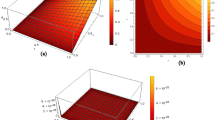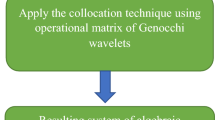Abstract
A scheme for approximating the kernel w of the fractional \(\alpha \)-integral by a linear combination of exponentials is proposed and studied. The scheme is based on the application of a composite Gauss–Jacobi quadrature rule to an integral representation of w. This results in an approximation of w in an interval \([\delta ,T]\), with \(0<\delta \), which converges rapidly in the number J of quadrature nodes associated with each interval of the composite rule. Using error analysis for Gauss–Jacobi quadratures for analytic functions, an estimate of the relative pointwise error is obtained. The estimate shows that the number of terms required for the approximation to satisfy a prescribed error tolerance is bounded for all \(\alpha \in (0,1)\), and that J is bounded for \(\alpha \in (0,1)\), \(T>0\), and \(\delta \in (0,T)\).







Similar content being viewed by others
References
Diethelm, K., Ford, N.J., Freed, A.D.: A predictor-corrector approach for numerical solution of fractional differential equations. Nonlinear Dyn. 29, 3–22 (2002)
Yuste, S.B., Acedo, L.: An explicit finite difference method and a new Von Neumann-type stability analysis for fractional diffusion equations. SIAM J. Numer. Anal. 42(5), 1862–1874 (2005)
Jin, B., Lazarov, R., Zhou, Z.: Two fully discrete schemes for fractional diffusion and diffusion-wave equations with nonsmooth data. SIAM J. Sci. Comput. 38(1), A146–A170 (2016)
Brunner, H., Schötzau, D.: hp-Discontinuous Galerkin time-stepping for volterra integrodifferential equations. SIAM J. Numer. Anal. 44(1), 224–245 (2006)
Lubich, C., Schädle, A.: Fast convolution for nonreflecting boundary conditions. SIAM J. Sci. Comput. 24(1), 161–182 (2002)
Schädle, A., López-Fernández, M., Lubich, C.: Fast and oblivious convolution quadrature. SIAM J. Sci. Comput. 28(2), 421–438 (2006)
López-Fernández, M., Lubich, C., Schädle, A.: Adaptive fast and oblivious convolution in evolution equations with memory. SIAM J. Sci. Comput. 30(2), 1015–1037 (2008)
López-Fernández, M., Palencia, C., Schädle, A.: A spectral order method for inverting sectorial Laplace transforms. SIAM J. Numer. Anal. 44(3), 1332–1350 (2006)
Beylkin, G., Monzón, L.: Approximation by exponential sums revisited. Appl. Comput. Harmon. Anal. 28, 131–149 (2010)
Li, J.R.: A fast time stepping method for evaluating fractional integrals SIAM. J. Sci. Comput. 31(6), 4696–4714 (2010)
Baffet, D., Hesthaven, J.S.: A Kernel compression scheme for fractional differential equations. SIAM J. Numer. Anal. 55(2), 496–520 (2017)
Zeng, F., Turner, I., Burrage, K.: A stable fast time-stepping method for fractional integral and derivative operators. arXiv:1703.05480 (2017)
McLean, W.: Exponential sum approximations for \(t^{-\beta }\). arXiv:1606.00123 (2017)
Jiang, S., Zhang, J., Zhang, Q., Zhang, Z.: Fast evaluation of the caputo fractional derivative and its applications to fractional diffusion equations. Commun. Comput. Phys. 21(3), 650–678 (2017)
Baffet, D., Hesthaven, J.S.: High-order accurate adaptive kernel compression time-stepping schemes for fractional differential equations. J. Sci. Comput. 72(3), 1169–1195 (2017)
Diethelm, K., Ford, N.J.: Analysis of fractional differential equations. J. Math. Anal. Appl 265(2), 229–248 (2002)
Gautschi, W., Varga, R.S.: Error bounds for Gaussian quadrature of analytic functions. SIAM J. Numer. Anal. 20(6), 1170–1186 (1983)
Erdélyi, A.: Higher Transcendental Functions, vol. 2. McGraw-Hill, New York (1953)
Elliot, D.: Uniform asymptotic expansions of Jacobi polynomials and associated function. Math. Comp. 25(114), 309–315 (1971)
Olver, F.W.J.: The asymptotic solution of linear differential equations of the second order for large values of a parameter. Philos. Trans. R. Soc. A 247(930), 307–327 (1954)
Olver, F.W.J.: Uniform asymptotic expansions of linear second-order differential equations for large values of a parameter. Philos. Trans. R. Soc. A 250(984), 479–517 (1958)
Garrappa, R.: The Mittag-Leffler Function, MATLAB Central File Exchange, 2014, file ID: 48154
Acknowledgements
The author declares that he has no conflict of interests.
Author information
Authors and Affiliations
Corresponding author
Appendix: A Technical Lemma
Appendix: A Technical Lemma
Estimate (4.7) of Lemma 4.2 relies on the infimum of
for \(\ell \in (1,3)\). It is a simple exercise to show that for each \(J\ge 1\), \(R_J\) has a unique minimum point in (1, 3) and to estimate the asymptotic behavior of that minimum, at the limit \(J\rightarrow \infty \). This is summarized in the following lemma.
Lemma A.1
For each \(J\ge 1\), \(R_J\) has a unique minimizer \(\ell _J\) in (1, 3) given by
In particular \(\ell _J\in (3/2,3)\), and at the limit \(J\rightarrow \infty \), there holds
Proof
The derivative of \(R_J\) is given by
Thus, the critical points of \(R_J\), satisfy
It is therefore clear that \(R_J\) has a unique critical point and that this point is the unique minimizer of \(R_J\) in (1, 3). By squaring the last equality, we find that \(\ell =\ell _J\) is a solution of the following equation
This equation has only one solution smaller than three given by
Indeed, there holds
At the limit where J tends to infinity, we have
and therefore
where \(\rho =3+\sqrt{8}\). Thus we recover
which completes the proof. \(\square \)
Rights and permissions
About this article
Cite this article
Baffet, D. A Gauss–Jacobi Kernel Compression Scheme for Fractional Differential Equations. J Sci Comput 79, 227–248 (2019). https://doi.org/10.1007/s10915-018-0848-x
Received:
Revised:
Accepted:
Published:
Issue Date:
DOI: https://doi.org/10.1007/s10915-018-0848-x




